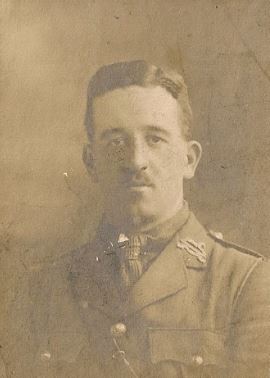Capt
Leslie Wilfrid Callaghan
Informations sur naissance
|
Date de naissance: 28/10/1891 |
|
Lieu de naissance: Blackrock, Dublin, Irlande, Royaume-Uni |
Informations générales
|
Profession: Employé des chemins de fer |
Informations service militaire
|
Pays: Angleterre, Royaume-Uni |
|
Force armée: British Expeditionary Force |
|
Rang: Captain |
|
Numéro de service: / |
|
Unités: — West Yorkshire Regiment (Prince of Wales's Own), 1/8th Bn. (Leeds Rifles) (Dernière unité connue) |
Informations sur décès
|
Date de décès: 09/10/1917 |
|
Lieu de décès: Yetta Houses, Zonnebeke, Belgique |
|
Cause du décès: Killed in action (K.I.A.) |
|
Âge: 25 |
Mémorial
|
Tyne Cot Memorial Panneau: 42 |
Distinctions et médailles 3
|
1914-15 Star Médaille |
|
British War Medal Médaille |
|
Victory Medal Médaille |
Points d'intérêt 1
| #1 | Lieu de naissance |
Mon histoire
Captain Leslie Wilfrid Callaghan served in the West Yorkshire Regiment (Prince of Wales's Own), 1st/8th (Leeds Rifles) 8th Battalion, part of the 146th Brigade of the 49th (West Riding) Division. The Division participated in the Third Battle of Ypres, also known as the Battle of Passchendaele.
It attacked on the 9th of October 1917, known as the Battle of Poelcapelle. The Division’s attack was carried by the 148th Brigade on the right and the 146th Brigade on the left. The latter deployed the 1/5th, 1/7th and 1/8th West Yorkshire Regiment Battalions during the attack, the 1/6th was kept in reserve.
The 1/8th Battalion advanced from positions South of Gravenstafel towards Wallemolen, South of the village of Poelcapelle, at zero hour, 5.20 a.m. “B” and “C” Companies were to capture the first objective. A line near Yetta Houses. “A” and “D” Companies were to move through the line at Yetta Houses and consolidate a line near the Wallemolen Cemetery. The Battalion had marched the whole night to reach their jump-off positions and arrived only five minutes before the sign was given to attack. Machine-gun and rifle bullets swept the line of advance and casualties soon became very heavy. Especially among officers and N.C.O.’s the losses were severe. The unforgiving German machine-gun and rifle fire was so heavy that the 1/8th Battalion could only advance about 300 yards. Battalion Headquarters were established in Kronprinz Farm and the men dug in around the Farm. They held this position tenaciously till the next day, when they were relieved.
West Yorkshire Regiment (Prince of Wales's Own), 1st/8th (Leeds Rifles) 8th Battalion suffered heavy casualties . Out of twenty-three officers who joined the attack, ten were killed, eight were wounded and one went missing. The other ranks suffered 301 casualties, wounded, killed or missing.
Captain Leslie Wilfrid Callaghan was one of the eight officers who fell during the Battalion’s attack on Yetta Houses, during the Battle of Poelcapelle on the 9th of October 1917. His remains were never recovered and he is now remembered on the Tyne Cot Memorial.
It attacked on the 9th of October 1917, known as the Battle of Poelcapelle. The Division’s attack was carried by the 148th Brigade on the right and the 146th Brigade on the left. The latter deployed the 1/5th, 1/7th and 1/8th West Yorkshire Regiment Battalions during the attack, the 1/6th was kept in reserve.
The 1/8th Battalion advanced from positions South of Gravenstafel towards Wallemolen, South of the village of Poelcapelle, at zero hour, 5.20 a.m. “B” and “C” Companies were to capture the first objective. A line near Yetta Houses. “A” and “D” Companies were to move through the line at Yetta Houses and consolidate a line near the Wallemolen Cemetery. The Battalion had marched the whole night to reach their jump-off positions and arrived only five minutes before the sign was given to attack. Machine-gun and rifle bullets swept the line of advance and casualties soon became very heavy. Especially among officers and N.C.O.’s the losses were severe. The unforgiving German machine-gun and rifle fire was so heavy that the 1/8th Battalion could only advance about 300 yards. Battalion Headquarters were established in Kronprinz Farm and the men dug in around the Farm. They held this position tenaciously till the next day, when they were relieved.
West Yorkshire Regiment (Prince of Wales's Own), 1st/8th (Leeds Rifles) 8th Battalion suffered heavy casualties . Out of twenty-three officers who joined the attack, ten were killed, eight were wounded and one went missing. The other ranks suffered 301 casualties, wounded, killed or missing.
Captain Leslie Wilfrid Callaghan was one of the eight officers who fell during the Battalion’s attack on Yetta Houses, during the Battle of Poelcapelle on the 9th of October 1917. His remains were never recovered and he is now remembered on the Tyne Cot Memorial.
Sources 3
|
1/8 Battalion West Yorkshire Regiment , (The National Archives, KEW (TNA), WO 95/2795/2 ). https://discovery.nationalarchives.gov.uk/details/r/C14303 Autre référence |
|
McCarthy C.,, The Third Ypres Passchendaele. The Day-by-Day Account, (London, Arms & Armour Press, 1995), pg. 107-108. Sources utilisées |
|
Wyrall E., The West Yorkshire Regiment in the War 1914-1918 Volume Two, (London, John Lane The Bodley Head LTD, 1927), pg. 122-126. Sources utilisées |
Complément d’informations 3
|
Commonwealth War Graves Commission Database https://www.cwgc.org/find-records/find-war-dead/casualty-details/1627880 |
|
Namenlijst (In Flanders Fields Museum) https://namenlijst.org/publicsearch/#/person/_id=4a88cb27-8cfe-4bb7-b7fa-d077a3aff1f0 |
|
Lives of the First World War (Imperial War Museum) https://livesofthefirstworldwar.iwm.org.uk/lifestory/5431712 |
